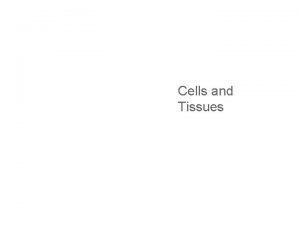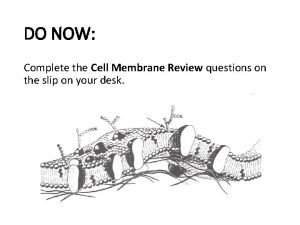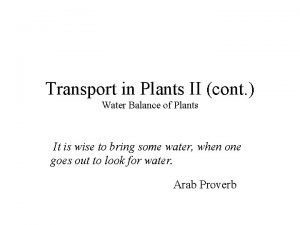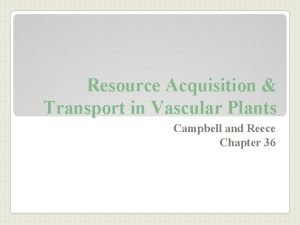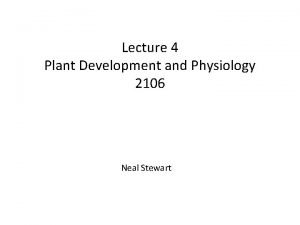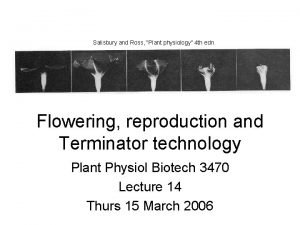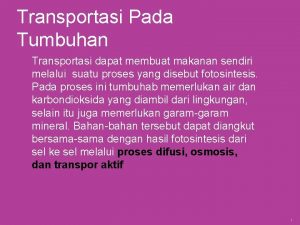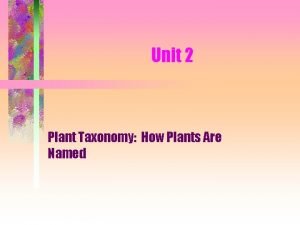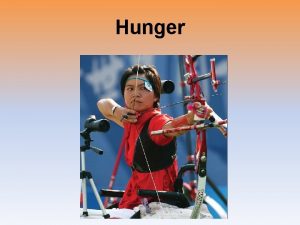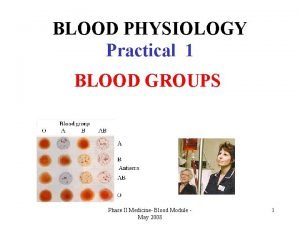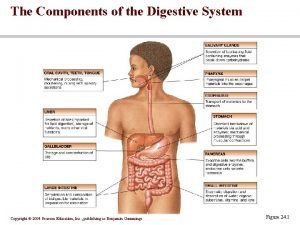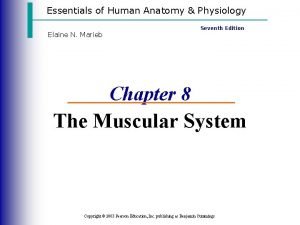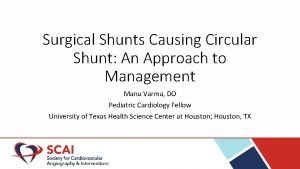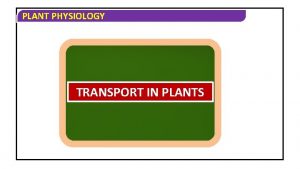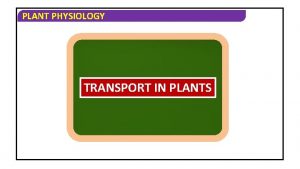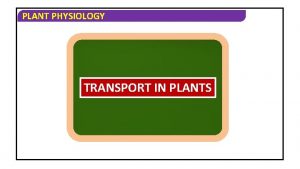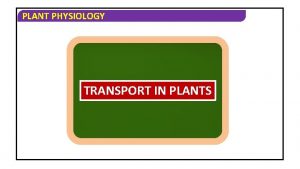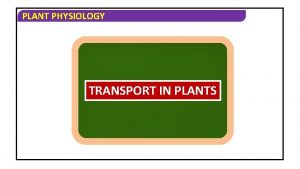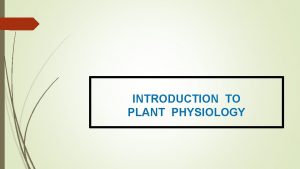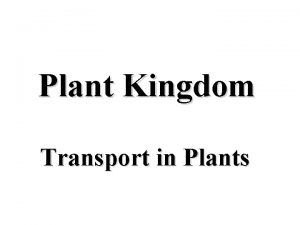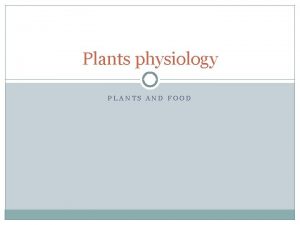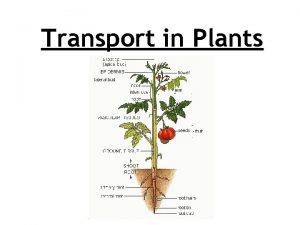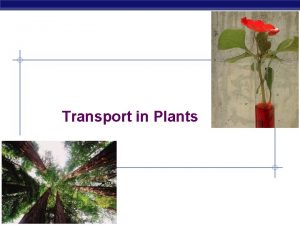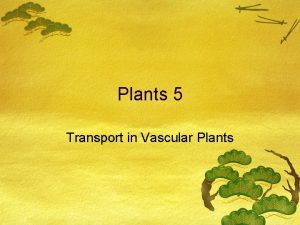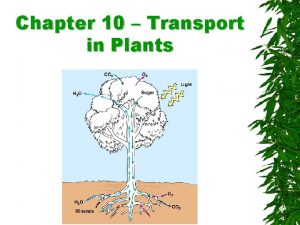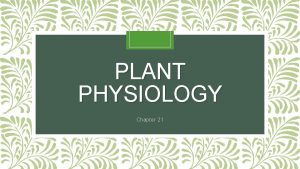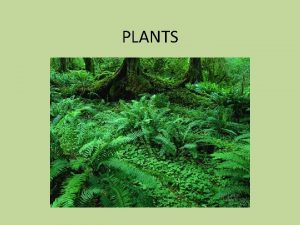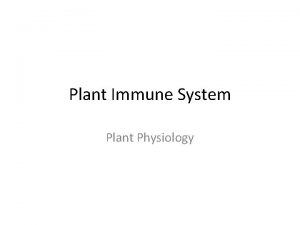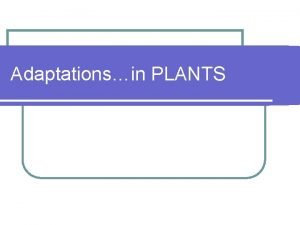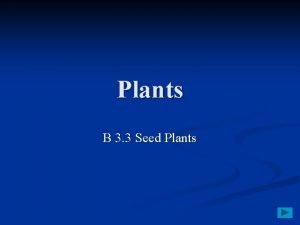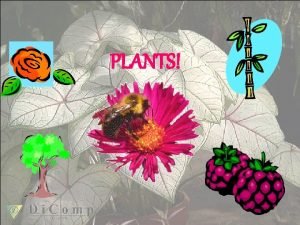PLANT PHYSIOLOGY TRANSPORT IN PLANTS PLANT PHYSIOLOGY PLANT







































- Slides: 39

PLANT PHYSIOLOGY TRANSPORT IN PLANTS

PLANT PHYSIOLOGY

PLANT PHYSIOLOGY c) Plasmolysis v The behaviour of the plant cells (or tissues) with regard to water movement depends on the surrounding solution. Isotonic: v The external solution balances the osmotic pressure of the cytoplasm.

PLANT PHYSIOLOGY Hypotonic: § The external solution is more dilute than the cytoplasm. Hypertonic: § The external solution is more concentrated than cytoplasm.

PLANT PHYSIOLOGY Cells swell in hypotonic soluti ons and shrink in hypertonic ones.

PLANT PHYSIOLOGY v Plasmolysis occurs when water moves out of the cell and cell membrane of a plant cell shrinks away from its cell wall. Onion Plasmolysis v This occurs when the cell (or tissue) is placed in a solution that is hypertonic (has more solutes) to the protoplasm.

PLANT PHYSIOLOGY v When water moves out (exosmosis); it is lost first from the cytoplasm to outside. v Then water moves from vacuole to the cytoplasm. v The water when drawn out of the cell through diffusion into the extracellular (outside cell) fluid causes the protoplast to shrink away from the walls.

PLANT PHYSIOLOGY v Initially, this phenomenon is indicated by shrinkage of protoplast, leading to the separation of plasma membrane from the cell wall in the corners. This stage is called incipient plasmolysis.

PLANT PHYSIOLOGY v When the cell is left in the hypertonic solution for more time, the protoplasm completely shrinks, now the cell is said to be plasmolysed. v The movement of water occurs across the membrane, moving from an area of higher water potential (from the cell) to an area of lower water potential (out side the cell).

PLANT PHYSIOLOGY v In flaccid cells the pressure potential becomes zero, hence the water potential becomes equal to the solute potential. Thus normal living cells when kept in hypertonic solution become flaccid. v Plasmolysis does not normally occur in nature–with the possible exception of extreme water stress or saline environments.

PLANT PHYSIOLOGY v The salting of pickles and preserving of fish and meat in salt are good examples of practical applications of plasmolysis.

PLANT PHYSIOLOGY v When the cell (or tissue) is placed in an isotonic solution, there is no net flow of water towards the inside or outside. Isotonic It is said to be in solution isotonic condition and as both are in a state of equilibrium, the net movement of water is zero. No net flow of water v The external solution balances the osmotic pressure of the cytoplasm.

PLANT PHYSIOLOGY v When the cells are placed in a hypotonic solution, water diffuses into the cell causing the cytoplasm to build up pressure against the wall. The process of plasmolysis is This is called usually turgor reversible. pressure. Hypotonic solution

PLANT PHYSIOLOGY v Because of the rigidity of the cell wall, the cell does not rupture. v Turgor pressure is ultimately responsible for the enlargement and extension or growth of cells.

PLANT PHYSIOLOGY d) Imbibition v Imbibition is a special type of diffusion when water is absorbed by solids – colloids –causing them to enormously increase in volume. e. g. Absorption of water by seeds and dry wood.

PLANT PHYSIOLOGY v The pressure that is produced by the swelling of wood was used by prehistoric man to split rocks and boulders. v Different types of organic substances have different imbibing capacities.

PLANT PHYSIOLOGY v Proteins have very high imbibing capacities compared to carbohydrates.

PLANT PHYSIOLOGY v That is why proteinaceous pea seeds swell more on imbibition than starchy wheat seeds.

PLANT PHYSIOLOGY v Imbibition is also a type of diffusion. Water movement is along a concentration gradient; the seeds and other such materials have almost no water, hence they absorb water easily. Water potential gradient between the adsorbent and the liquid imbibed is essential for imbibition.

PLANT PHYSIOLOGY 1. When the external solution is more dilute than the cytoplasm the solution is said to be……. 1) Hypertonic 2) Hypotonic 3) Isotonic 4) Both hypertonic and hypotonic MCQS

PLANT PHYSIOLOGY 2. Cells in hypotonic solution……. 1) Shrink 2) Normal 3) Swell 4) Burst

PLANT PHYSIOLOGY 3. Plasmolysis occurs in……. solution. 1) Hypertonic 2) Hypotonic 3) Isotonic 4) All

PLANT PHYSIOLOGY

PLANT PHYSIOLOGY Long Distance Transport of Water v When a twig bearing white flowers is placed in coloured water, the colour of flower changes into respective colour solution. v On examining the cut end of a twig after a few hours, you will notice the region through which coloured water moved.

PLANT PHYSIOLOGY v This experiment very easily demonstrates that the path of water movement is through the vascular bundles, more specially, the xylem.

PLANT PHYSIOLOGY v Long distance transport of substances within a plant cannot take place by diffusion alone. Becaus e… Diffusion is a slow process. It can account for only short distance movement of molecules.

PLANT PHYSIOLOGY So, it takes many years movement of v In large and complex for organisms, substances often move across very molecules over long large distances by diffusion alone.

PLANT PHYSIOLOGY v Sometimes the sites of production and sites of storage are too far from each other; diffusion or active transport would not suffice. v Special long distance transport systems become necessary so as to move substances across long distances and at a much faster rate.

PLANT PHYSIOLOGY v Water and minerals, and food are generally moved by a mass or bulk flow system.

PLANT PHYSIOLOGY v Mass flow is the movement of substances in bulk from one point to another as a result of pressure differences between the two points.

PLANT PHYSIOLOGY v It is a characteristic of mass flow that substances, whether in solution or in suspension, are swept along at the same pace, as in a flowing river. v This is unlike diffusion where different substances independently depending on their concentration gradients. move

PLANT PHYSIOLOGY v Bulk flow can be achieved either through: § A positive hydrostatic pressure gradient (e. g. , a garden hose). § A negative hydrostatic pressure gradient. (e. g, suction through a straw).

PLANT PHYSIOLOGY v The bulk movement of substances through the conducting or vascular tissues of plants is called translocation. v The higher plants have highly specialised vascular tissues-xylem and phloem.

PLANT PHYSIOLOGY v Xylem is associated with the translocation of mainly water, mineral salts, some organic nitrogen and hormones from the roots to the aerial parts of the plants.

PLANT PHYSIOLOGY v Phloem translocates a variety of organic and inorganic solutes, mainly from the leaves to other parts of the plants.

PLANT PHYSIOLOGY 1. The movement of a molecule across a typical cell by diffusion takes approximately……. 1) 2 sec 2) 2. 5 sec 3) 3 sec 4) 4 sec MCQ S

PLANT PHYSIOLOGY 2. Water and minerals are transported through……. 1) Diffusion 2) Osmosis 3) Active transport 4) Mass or bulk flow system

PLANT PHYSIOLOGY 3. The bulk movement of substances through the conducting or vascular tissues of plant is…. . 1) Transportation 2) Diffusion 3) Translocation 4) Absorption

PLANT PHYSIOLOGY Thank you…
 Cell physiology membrane transport
Cell physiology membrane transport Cell physiology membrane transport worksheet
Cell physiology membrane transport worksheet Primary active transport vs secondary active transport
Primary active transport vs secondary active transport Passive transport vs active transport venn diagram
Passive transport vs active transport venn diagram Bioflix activity membrane transport active transport
Bioflix activity membrane transport active transport Passive transport vs active transport venn diagram
Passive transport vs active transport venn diagram Active transport image
Active transport image Secondary active transport
Secondary active transport Endocytosis vs exocytosis
Endocytosis vs exocytosis Isotonic in biology
Isotonic in biology Primary vs secondary active transport
Primary vs secondary active transport Bulk flow in phloem
Bulk flow in phloem What does phloem transport
What does phloem transport Phylloxy
Phylloxy Nonvascular plants definition
Nonvascular plants definition Classify the non flowering plants with examples
Classify the non flowering plants with examples Photosynthesis equation
Photosynthesis equation Nonvascular plant diagram
Nonvascular plant diagram Plant celldiagram
Plant celldiagram Salisbury and ross
Salisbury and ross Plant physiology
Plant physiology Pengangkutan vaskuler adalah
Pengangkutan vaskuler adalah Unit 2 plant taxonomy how plants are named
Unit 2 plant taxonomy how plants are named Tronsmo plant pathology and plant diseases download
Tronsmo plant pathology and plant diseases download Scope of plant breeding
Scope of plant breeding Tronsmo plant pathology and plant diseases download
Tronsmo plant pathology and plant diseases download Plant breeding for disease resistance
Plant breeding for disease resistance Albugo eye
Albugo eye Plant introduction in plant breeding
Plant introduction in plant breeding Hunger contraction
Hunger contraction Clinical significance of blood grouping
Clinical significance of blood grouping Physiology of vision
Physiology of vision Muscle layer of stomach
Muscle layer of stomach Woody stem parts
Woody stem parts Anatomy and physiology
Anatomy and physiology Anaerobic exercise physiology
Anaerobic exercise physiology Macula densa
Macula densa Circular shunt physiology
Circular shunt physiology Aohs foundations of anatomy and physiology 1
Aohs foundations of anatomy and physiology 1 Largest nerve in the body
Largest nerve in the body
